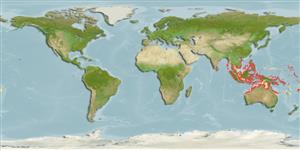>
Syngnathiformes (Pipefishes and seahorses) >
Syngnathidae (Pipefishes and seahorses) > Nerophinae
Etymology: Doryrhamphus: Greek, dory = lance + Greek, rhamphos = bill, beak (Ref. 45335).
More on authors: Herald & Randall.
Environment: milieu / climate zone / depth range / distribution range
Écologie
marin récifal; profondeur 0 - 35 m (Ref. 1602). Tropical; 19°N - 29°S
Western Central Pacific: Gulf of Thailand to the Solomon Islands, north to the Philippines, south to Queensland; Belau and Truk in Micronesia.
Taille / Poids / Âge
Maturity: Lm ? range ? - ? cm
Max length : 14.0 cm TL mâle / non sexé; (Ref. 48635)
Description synthétique
Clés d'identification | Morphologie | Morphométrie
Épines dorsales (Total) : 0; Rayons mous dorsaux (Total) : 22 - 25; Rayons mous anaux: 4. Superior trunk and tail ridges discontinuous; inferior trunk ridge ending on anal ring; lateral trunk ridge continuous with inferior tail ridge; body rings 16; tail rings 21-23.
Found in tide pools and reef crevices. Also found in sheltered inner reefs, usually in caves with sponges and below large plate corals. Ovoviviparous (Ref. 205). The male carries the eggs in a brood pouch which is found under the tail (Ref. 205). Very active cleaner and has cleaning station that is visited by apogonids and damsels where adults work in pairs (Ref. 48635). Minimum depth from Ref. 58018. Solitary or in pairs (Ref 90102).
Life cycle and mating behavior
Maturities | Reproduction | Spawnings | Egg(s) | Fecundities | Larves
Male carries the eggs in a brood pouch (Ref. 205).
Myers, R.F., 1991. Micronesian reef fishes. Second Ed. Coral Graphics, Barrigada, Guam. 298 p. (Ref. 1602)
Statut dans la liste rouge de l'IUCN (Ref. 130435)
Menace pour l'homme
Harmless
Utilisations par l'homme
Outils
Articles particuliers
Télécharger en XML
Sources Internet
Estimates based on models
Preferred temperature (Ref.
123201): 25.9 - 29.3, mean 28.7 °C (based on 2406 cells).
Phylogenetic diversity index (Ref.
82804): PD
50 = 0.5078 [Uniqueness, from 0.5 = low to 2.0 = high].
Bayesian length-weight: a=0.00085 (0.00032 - 0.00224), b=3.04 (2.81 - 3.27), in cm total length, based on LWR estimates for this (Sub)family-body shape (Ref.
93245).
Niveau trophique (Ref.
69278): 3.9 ±0.5 se; based on size and trophs of closest relatives
Résilience (Ref.
120179): Haut, temps minimum de doublement de population inférieur à 15 mois (Preliminary K or Fecundity.).
Fishing Vulnerability (Ref.
59153): Low vulnerability (10 of 100).
Nutrients (Ref.
124155): Calcium = 135 [77, 258] mg/100g; Iron = 1.09 [0.62, 1.83] mg/100g; Protein = 17.7 [16.5, 18.9] %; Omega3 = 0.117 [0.065, 0.214] g/100g; Selenium = 35.2 [18.0, 79.8] μg/100g; VitaminA = 109 [38, 317] μg/100g; Zinc = 1.7 [1.1, 2.5] mg/100g (wet weight);
